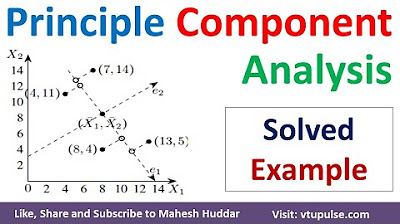10.3 Probabilistic Principal Component Analysis (UvA - Machine Learning 1 - 2020)
Summary
TLDRThis video covers the concept of Principal Component Analysis (PCA) from a probabilistic perspective. It explains how PCA can be used for dimensionality reduction, data compression, and noise reduction, while emphasizing the importance of selecting the number of components in the model. The probabilistic PCA model provides a generative approach with Gaussian distributions, and a Bayesian framework is introduced for automating the selection of the latent space dimension. The video concludes by discussing the limitations of linear models and hints at non-linear PCA models for future exploration.
Takeaways
- 😀 PCA can be viewed as a method for dimensionality reduction, where the goal is to preserve maximum variance in the data.
- 😀 PCA can also be understood as a technique for reconstructing original data by minimizing the reconstruction error.
- 😀 Probabilistic PCA (PPCA) introduces a probabilistic framework, allowing us to model data distributions and draw samples from them.
- 😀 In PPCA, the latent space dimension (m) controls the balance between noise and data trust. A small m implies more noise, while a large m trusts the data more.
- 😀 A Bayesian approach can be used to automatically select the optimal latent space dimension (m), removing the need for manual model selection.
- 😀 PPCA can be solved using closed-form solutions, but sometimes Expectation Maximization (EM) algorithms are employed for convenience.
- 😀 The probabilistic PCA model approximates the true covariance of the data by optimizing parameters such as mean (mu), variance (sigma squared), and weights (w).
- 😀 PCA has several practical applications, including dimensionality reduction, 2D/3D visualization, data compression, whitening (decorrelating features), and denoising.
- 😀 PCA relies on linear models, which limits its capability in capturing non-linear relationships within data.
- 😀 The next step after PCA will explore non-linear versions of PCA to address the limitations of linear models, opening up new possibilities for data modeling.
Q & A
What is the primary goal of Principal Component Analysis (PCA)?
-The primary goal of PCA is to reduce the dimensionality of data while preserving as much variance as possible. It does so by finding a lower-dimensional subspace that captures the most important features of the data.
How does PCA achieve dimensionality reduction?
-PCA achieves dimensionality reduction by identifying the principal components, which are the directions in which the data varies the most. These components form a new basis for the data, allowing it to be represented with fewer dimensions.
What are the two main ways PCA can be used according to the transcript?
-PCA can be used for dimensionality reduction, where the goal is to simplify the data by projecting it onto a lower-dimensional subspace, and for data compression, where the goal is to represent the data in fewer bits without losing significant information.
What is the difference between PCA and Probabilistic PCA (PPCA)?
-PCA is a linear technique that focuses on finding a lower-dimensional subspace, whereas Probabilistic PCA introduces a probabilistic model, treating the data as being generated from a Gaussian distribution. PPCA allows for generating new samples and also incorporates uncertainty in the modeling process.
Why is the choice of the number of components (m) important in PPCA?
-The number of components (m) controls the trade-off between noise and data structure. A low value of m assumes more noise, discarding many components, while a high value of m assumes the data has a more complex structure and closely models the data distribution.
How does PPCA handle noise in the data?
-In PPCA, noise is handled by discarding components that are considered unimportant or noisy. This allows the model to focus on the true underlying structure of the data, minimizing the effect of noise in the reconstruction.
What is the role of Expectation-Maximization (EM) in PPCA?
-Expectation-Maximization (EM) is an algorithm that can be used to optimize PPCA by finding the best parameters for the model, particularly when there are missing or uncertain data. It iteratively improves the estimation of the latent variables and model parameters.
What are some practical applications of PCA as mentioned in the transcript?
-PCA can be used for dimensionality reduction, 2D or 3D data visualization, data compression, whitening data, and denoising. These applications help make high-dimensional data easier to analyze and interpret.
How does PCA aid in data whitening?
-PCA aids in data whitening by transforming the data so that its features are uncorrelated and have unit variance. This process makes the data easier to analyze, as it removes redundant information and scales the features uniformly.
What is a limitation of the current PCA approach, as discussed in the transcript?
-A limitation of the current PCA approach is that it is based on linear models, which may not capture complex, non-linear relationships in the data. The transcript mentions that future discussions will cover non-linear models to address this limitation.
Outlines

Этот раздел доступен только подписчикам платных тарифов. Пожалуйста, перейдите на платный тариф для доступа.
Перейти на платный тарифMindmap

Этот раздел доступен только подписчикам платных тарифов. Пожалуйста, перейдите на платный тариф для доступа.
Перейти на платный тарифKeywords

Этот раздел доступен только подписчикам платных тарифов. Пожалуйста, перейдите на платный тариф для доступа.
Перейти на платный тарифHighlights

Этот раздел доступен только подписчикам платных тарифов. Пожалуйста, перейдите на платный тариф для доступа.
Перейти на платный тарифTranscripts

Этот раздел доступен только подписчикам платных тарифов. Пожалуйста, перейдите на платный тариф для доступа.
Перейти на платный тарифПосмотреть больше похожих видео

PCA Algorithm | Principal Component Analysis Algorithm | PCA in Machine Learning by Mahesh Huddar

StatQuest: PCA in Python

1 Principal Component Analysis | PCA | Dimensionality Reduction in Machine Learning by Mahesh Huddar

Pembahasan Analisis Komponen Utama (Part 1) | Review Konsep

Week 3 Lecture 13 Principal Components Regression

StatQuest: PCA main ideas in only 5 minutes!!!
5.0 / 5 (0 votes)
